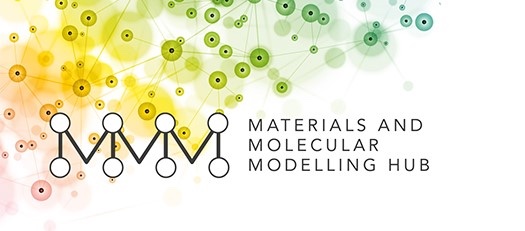
- This event has passed.
MMM Hub Conference & User Meeting 2024
29 October 2024 @ 1:30 pm – 31 October 2024 @ 1:30 pm
Venue: Battle of Britain Bunker, Wren Ave, Uxbridge UB10 0GG
The Materials and Molecular Modelling (MMM) Hub is holding a conference and user meeting between 29-31 October 2024, to bring together the national community of modellers in materials and theoretical chemistry to present the latest research in the field, and provide the opportunity to network and discuss with like-minded researchers. The meeting is taking place at the Battle of Britain Bunker, Wren Ave, Uxbridge UB10 0GG, close to Brunel University London.
The conference will highlight the high-calibre scientific throughput produced across the MMM Hub’s partner community and beyond, highlighting particularly the contribution of modern HPC resources (including MMM Hub’s ‘Young’), in enabling these advances. A selection of breakthrough materials and molecular modelling research taking place across the country will be presented, addressing challenges to society and industry through simulation at the atomic scale, alongside discussion in emerging computing trends and how this impacts materials scientists.
Topics will include, but not be limited to, molecular modelling, biological and technological soft matter, functional materials and devices, structural materials, surfaces and interfaces and methods and method development. The meeting will provide an excellent opportunity for researchers at all levels to learn about the forefront of this important field in numerical simulation, and to showcase their most recent results.
The meeting will see a number of invited and contributed talks, plus a selection of 2-minute flash talks from across the community. We also invite participants, particularly graduate student users of the Hub, to contribute A1-size, portrait orientation posters of their research. The posters will be on display to participants throughout the day, and at a drinks reception and Poster Presentation.
Tuesday 29th October 2024
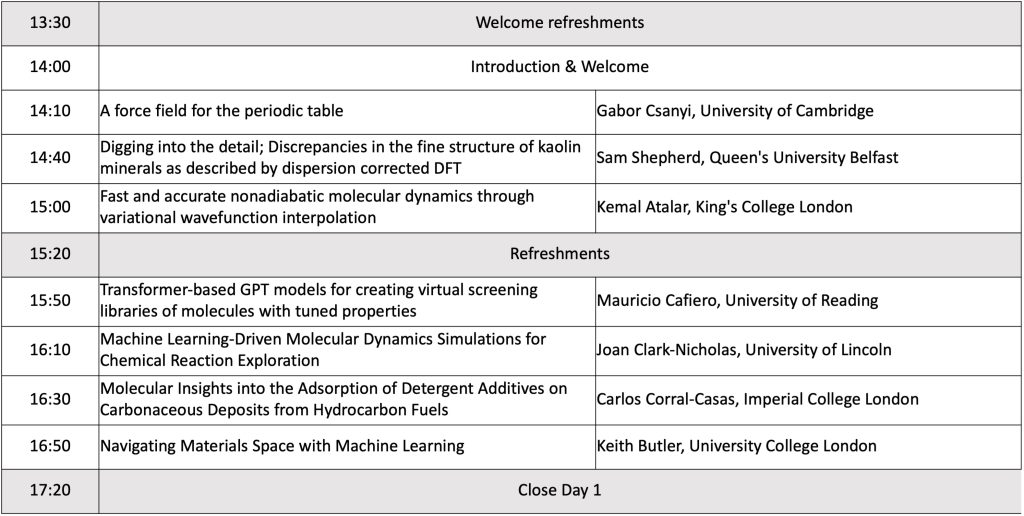
Wednesday 30th October
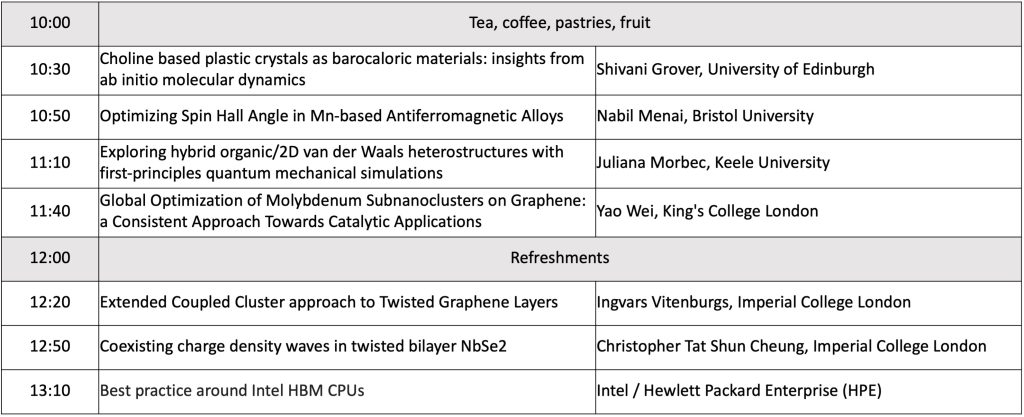

Thursday 31st October
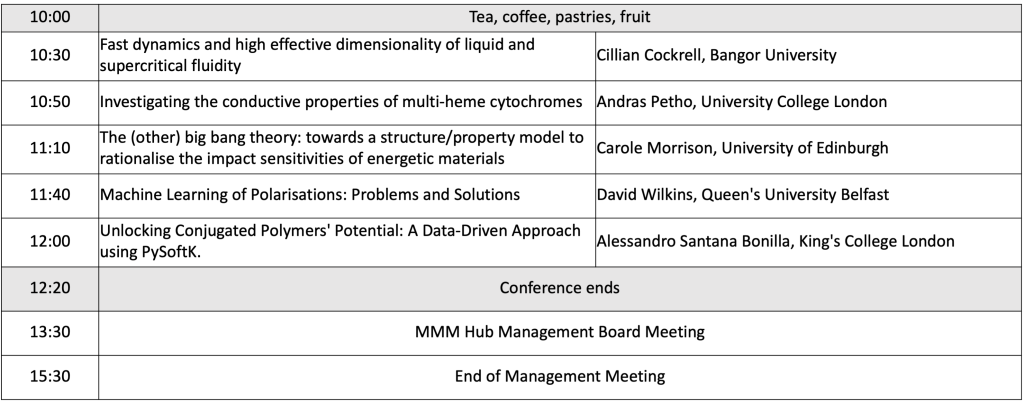
Invited speakers
Navigating Materials Space with Machine Learning – Keith Butler, University College London
The discovery and design of new materials is critical for advancing carbon-emission reducing technologies such as renewable energy and electric vehicles. Experimental discovery of new materials is typically slow and costly, quantum mechanics (QM) calculations have brought computational materials design within reach. However, QM calculations are often limited to relatively small sets of materials, as their computational costs are too great for large-scale screening, this is the case for calculating properties required for new energy materials. New methods in machine learning (ML) and deep learning (DL) have emerged as a powerful complementary tool to QM calculations – learning rules from data calculated from QM and applying cheap, efficient models to explore large chemical spaces. However, several challenges still exist for example, learning from small and limited datasets, obtaining measures of confidence in models and understanding the results of DL models. All these challenges must be addressed to fully realise the power of DL for design of new sustainable materials. In this talk I will give examples of recent work in our group to address these issues, including using unsupervised learning to accelerate the characterisation of battery materials without requiring labelled data[1], building models with reliable uncertainty quantification [2], capable of learning on significantly smaller datasets than regular DL models and using DL to match experimental and simulated data [3]. Finally, I will also discuss how the latest exciting developments in large language models could help to solve the challenges of crystal structure prediction [4].
1 Versatile domain mapping of scanning electron nanobeam diffraction datasets utilising variational autoencoders npj Computational Materials 9 (1), 14, 2023
2 Entropy-based active learning of graph neural network surrogate models for materials properties The Journal of Chemical Physics 155 (17), 174116, 2021
3 Using generative adversarial networks to match experimental and simulated inelastic neutron scattering data Digital Discovery 2.578, 2023
4 Crystal Structure Generation with Autoregressive Large Language Modeling arXiv preprint arXiv:2307.04340, 2023
A force field for the periodic table – Gábor Csányi, University of Cambridge
A new computational task has been defined and solved over the past 15 years for extended material systems: the analytic fitting of the Born-Oppenheimer potential energy surface as a function of nuclear coordinates. The resulting potentials (“force fields”) are reactive, many-body, with evaluation costs that are currently on the order of 0.1-10 ms/atom/cpu core (or about 1-10ms on a powerful GPU), and reach accuracies of a few meV/atom when trained specifically for a given system using iterative or active learning methods. The latest and most successful architectures leverage many-body symmetric descriptions of local geometry and equivariant message passing networks. Perhaps the most surprising recent result is the stability of models trained on very diverse training sets across the whole periodic table. Our recently discovery is that the MACE-MP-0 model that was trained on just ~150,000 real and hypothetical small inorganic crystals (90% of training set < 70 atoms), is capable of stable molecular dynamics at ambient conditions on any system tested so far – this includes crystals, liquids, surfaces, clusters, molecules, and combinations of all of these. The astounding generalisation performance of such foundation models open the possibility to creating a universally applicable interatomic potential with useful accuracy (especially when fine-tuned with a little bit of domain-specific data), and democratise quantum-accurate large scale molecular simulations by lowering the barrier to entry into the field.
Identifying CO2 Conversion Catalysts: High-Throughput DFT Calculations, Machine Learning, and Beyond – Devis Di Tommaso, Queen Mary University of London
The rising carbon dioxide (CO2) level and overall concentrations in the atmosphere due to fossil fuel combustion, a major cause of global warming, pose a serious threat to humankind. One of the most promising solutions to mitigating this risk is the chemical conversion of gaseous CO2 into value-added chemicals and materials. Catalysts can facilitate favourable pathways to reduce the overall energy requirements of the electrochemical CO2 reduction reaction (eCO2RR). The eCO2RR has emerged as a potential strategy for converting CO2 because if coupled with electricity from renewable sources (wind, solar, or hydropower plants), the eCO2RR could achieve a carbon-neutral energy cycle [1]. Unfortunately, due to the inertness of CO2, the main challenge is to find a specific catalyst capable of accelerating the sluggish kinetics of the eCO2RR. In this talk, I will give an overview of computational strategies we have developed based on the u quantum chemical methods [2-4], high-throughput calculations [5], and machine learning [6, 7] methods to accelerate the discovery of earth-abundant and active metal-based catalysts..
References:
[1] Z. Wang, Y. Zhou, P. Qiu, C. Xia, W. Fang, J. Jin, L. Huang, Y. Q. Su, R. Crespo-Otero, X. Tian, B. You, W. Guo, D. Di Tommaso, Y. Pang, S. Ding, and B. Y. Xia, Advanced catalyst design and reactor configuration upgrade in electrochemical carbon dioxide conversion, Advanced Materials, 2023, 35, 2303052;
[2] W. Lin, A. G. Nabi, M. Palma, and D. Di Tommaso, Copper nanowires for electrochemical CO2 reduction reaction, ACS Applied Nano Materials, 2024, doi: 10.1021/acsanm.3c06116;
[3] Q. Zhao, K. Lei, B. Yu Xia, R. Crespo-Otero, and D. Di Tommaso, Molecular engineering binuclear copper catalysts for selective CO2 reduction to C2 products, Journal of Energy Chemistry, 2024, 90, 166-173;
[4] Q. Zhao, R. Crespo-Otero, and D. Di Tommaso, The role of copper in enhancing the performance of heteronuclear diatomic catalysts for the electrochemical CO2 conversion to C1 chemicals, Journal of Energy Chemistry, 2023, 85, 490–500;
[5] Ab initio random structure searching and catalytic properties of copper-based nanocluster with Earth-abundant metals for the electrocatalytic CO2-to-CO conversion, A. G. Nabi, A. ur Rehman, A. Hussain, and D. Di Tommaso, Molecular Catalysis, 2022, 527, 112406;
[6] A. Muthuperiyanayagam and D. Di Tommaso, Electrocatalytic CO2 reduction on amorphous Cu surfaces: Unveiling structure-activity relationships, ChemRxiv, 2024, doi: 10.26434/chemrxiv-2024-bxqmn;
[7] M. Anselmi, G. Slabaugh, R. Crespo-Otero, and D. Di Tommaso, Molecular graph transformer: stepping beyond ALIGNN into long-range interactions, Digital Discovery, 2024, DOI: 10.1039/D4DD00014E
The (other) big bang theory: towards a structure/property model to rationalise the impact sensitivities of energetic materials – Carole A. Morrison, University of Edinburgh
Impact sensitivity is a measure of how much mechanical energy is required to initiate explosives and propellants. This important safety metric is typically measured by a simple experiment, where a known weight is dropped from an increasing height, until the minimum threshold energy is observed. However, the data obtained (essentially a binary call of ‘go, no-go’) is prone to user interpretation and variations in sample purity, crystallinity, temperature, humidity etc. This uncertainty in the experimental measurement has driven the need for physical models that can successfully link the chemical structure to the material property.
Over the last five or so years we have developed a condensed phase model that can link the crystal structure, via its phonon density of states (computed using plane-wave DFT), to its impact sensitivity. Based on the principles of vibrational up-pumping we have now successfully applied this model to ca. 40 energetic materials. However, while it is important for a model to predict the desired property from the given structure, the reverse process is actually more powerful, i.e. for a desired impact sensitivity what sort of molecules should I make? For this more data is needed, and our existing workflow becomes unmanageable. In short, it’s time to think about machine learning.
This talk outlines our approach to building a machine learning model for impact sensitivity using features we learned from our vibrational up-pumping model, alongside others that can act to guide synthetic chemists in molecular design. We also consider how to approach the issue of uncertainty in the experimental dataset.
Exploring hybrid organic/2D van der Waals heterostructures with first-principles quantum mechanical simulations – Juliana Morbec, Keele University
Combining two-dimensional (2D) materials with organic materials can be highly attractive for applications that require flexibility and where size and weight are important parameters, such as in wearable, portable, and mobile devices. Organic materials often exhibit excellent optical absorption efficiency and photo- and temperature-induced conformational changes, while 2D materials tend to demonstrate relatively high carrier mobility, superior mechanical flexibility, and tunable electronic and optical properties. Combining both systems can stabilize the organic materials and create heterostructures with both high carrier mobility and high optical absorption efficiency, which is promising for solar energy conversion. In this work, we investigate heterostructures composed of organic molecules (e.g., pentacene and azulene) and transition metal dichalcogenides (TMDs) for application in photovoltaic devices, using density-functional-theory calculations. We examine the interaction between the molecules and monolayer TMDs, as well as the band alignment of the heterostructures, considering the effects of molecular coverage, rotation, and dielectric screening.
This year’s MMM Hub Conference is supported by AWE, Hewlett Packard Enterprise (HPE), The American Society for Mechanical Engineers (ASME), RSC Advances, and RSC Molecular Systems Design & Engineering (MSDE)
RSC MSDE are offering up to 2 MSDE sponsored poster/presentation prizes each consisting of a certificate, £200 RSC Books voucher and a free RSC student membership for a year.
RSC Advances is offering a £100 prize to a winning poster presenter.
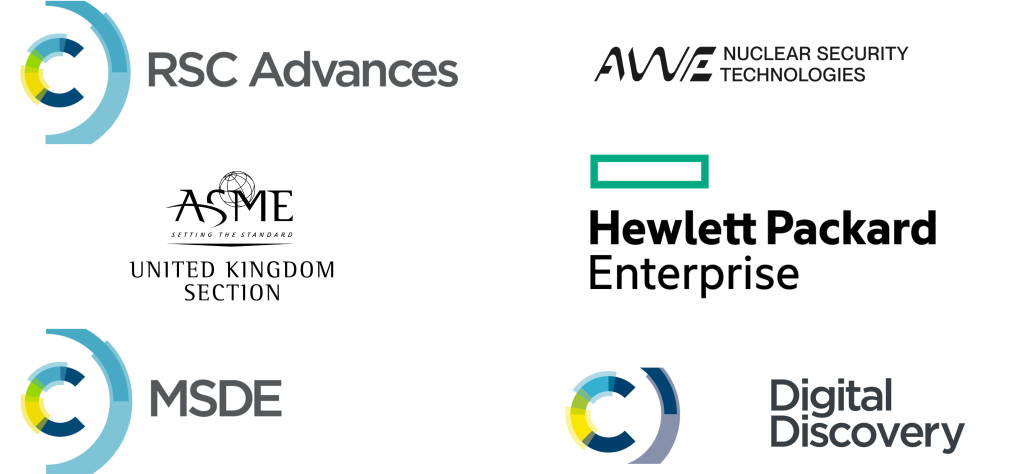
Getting to the Battle of Britain Bunker
- BY TUBE:Nearest station Uxbridge (Metropolitan and Piccadilly), then one mile walk through Dowding Parkvia the High Street and St Andrews Road, signposted by blue and brown tourist signs. There is a cab rank at Uxbridge.BY BUS: To St. Andrew’s Church on the A10 or U3 from Heathrow or the 427, U1, U4 or U7 then walk through Dowding Park. Bus U2 stops at the junction of Hercies Road and Honey Hill. Check routes at www.tfl.gov.uk/plan-a-journey
- BY CAR: Use satnav postcode UB10 0GG or search maps for Battle of Britain Bunker

ACCESS
There are accessible parking spaces available near the main entrance, a lift inside the building and a ramp up to the building.
Suggested hotel: Premier Inn, Colham House, Bakers Road, Uxbridge, UB8 1QJ
MMM-Hub-conference-2024-privacy-notice
Code of conduct:
We value the participation of every member of the materials and molecular modelling community and want to ensure that everyone has an enjoyable and fulfilling experience, both professionally and personally. Accordingly, all participants of the MMM Hub Conference and User meeting are expected to always show respect and courtesy to others. The MMM Hub and its partners strive to maintain inclusivity in all of our activities. All participants (staff and students) are entitled to a harassment-free experience, regardless of gender identity and expression, sexual orientation, disability, physical appearance, body size, race, age, and/or religion. Harassment in any form is not acceptable for any of us. We respectfully ask all attendees of the MMM Hub Conference and User meeting to kindly conform to the following Code of Conduct:
- Treat all individuals with courtesy and respect.
- Be kind to others and do not insult or put down other members.
- Behave professionally. Remember that harassment and sexist, racist, or exclusionary jokes are not appropriate.
- Harassment includes, but is not limited to, offensive verbal comments related to gender, sexual orientation, disability, physical appearance, body size, race, religion, sexual images in public spaces, deliberate intimidation, stalking, following, harassing photography or recording, sustained disruption of discussions, and unwelcome sexual attention.
- Participants asked to stop any harassing behaviour are expected to comply immediately.
- Contribute to communications with a constructive, positive approach.
- Be mindful of talking over others during presentations and discussion and be willing to hear out the ideas of others.
- All communication should be appropriate for a professional audience, and be considerate of people from different cultural backgrounds. Sexual language and imagery are not appropriate at any time.
- Challenge behaviour, action and words that do not support the promotion of equality and diversity.
- Arrive at the conference events punctually where possible.
- Show consideration for the welfare of your friends and peers and, if appropriate, provide advice on seeking help.
- Seek help for yourself when you need it.
MMM Hub Conference 2024 Organising Committee
George Booth, King’s College London
Alejandro Santana Bonilla, King’s College London
Ricardo Grau-Crespo, University of Reading
Ed Smith, Brunel University London
Karen Stoneham, University College London
David Wilkins, Queen’s University Belfast
Jun Xia, Brunel University London
